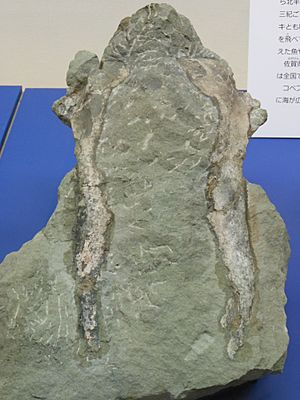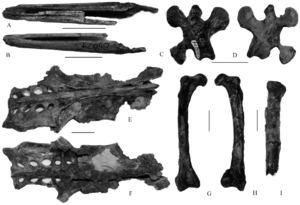Plotopterids facts for kids
Quick facts for kids Plotopterids |
|
|---|---|
 |
|
| Copepteryx | |
| Scientific classification |
|
| Kingdom: | Animalia |
| Phylum: | Chordata |
| Class: | Aves |
| Order: | Suliformes |
| Family: | †Plotopteridae Howard, 1969 |
| Genera | |
|
Copepteryx |
|
Plotopterids were a fascinating group of extinct birds. They were a family of flightless seabirds. These birds lived a very long time ago, from the Eocene to the Miocene periods.
They were related to modern-day gannets and boobies. What makes plotopterids special is how much they looked like penguins. Even though they lived in the North Pacific and penguins live in the Southern Hemisphere, they evolved similar body shapes. This is called convergent evolution. It means different animals can develop similar features if they live in similar environments.
However, scientists have found some differences. The bones in their shoulders, wings, and chest were not exactly like those of penguins. This means they might have swum a bit differently. Some scientists also think plotopterids might share a common ancestor with penguins because their brains look similar.
Contents
Where Plotopterids Lived
Fossils of plotopterids have been found in several places. These include California, Oregon, and Washington in the United States. They have also been found in British Columbia, Canada, and in Japan. This shows they lived across a wide area in the North Pacific Ocean.
What Plotopterids Looked Like
Plotopterids came in different sizes. Some were as big as a large cormorant, like a Brandt's cormorant. Others could grow up to 2 meters (about 6.5 feet) long!
They had short, strong wings. These wings were perfect for swimming underwater. Like penguins, they used their wings to "fly" through the water to catch food. Their body skeleton was also similar to a bird called a darter, which is known for its diving skills.
One species, named Tonsala hildegardae, was found in Washington State. Scientists have found many fossils of this bird. Some of these fossils even showed tiny holes. These holes were made by a special marine worm called Osedax, which eats bone.
When Plotopterids Disappeared
The oldest known plotopterid is Phocavis maritimus. It lived in the late Eocene period. Most plotopterid species lived during the Oligocene time. They finally became extinct in the early to mid-Miocene period.
It's interesting that plotopterids disappeared around the same time as the giant penguins in the Southern Hemisphere. This period also saw a rise in marine mammals like seals and dolphins. Some scientists wonder if the increase in these marine mammals led to the extinction of plotopterids. Perhaps they competed for the same food or hunting grounds. However, this idea still needs more scientific study.
See also
 In Spanish: Plotopteridae para niños
In Spanish: Plotopteridae para niños



